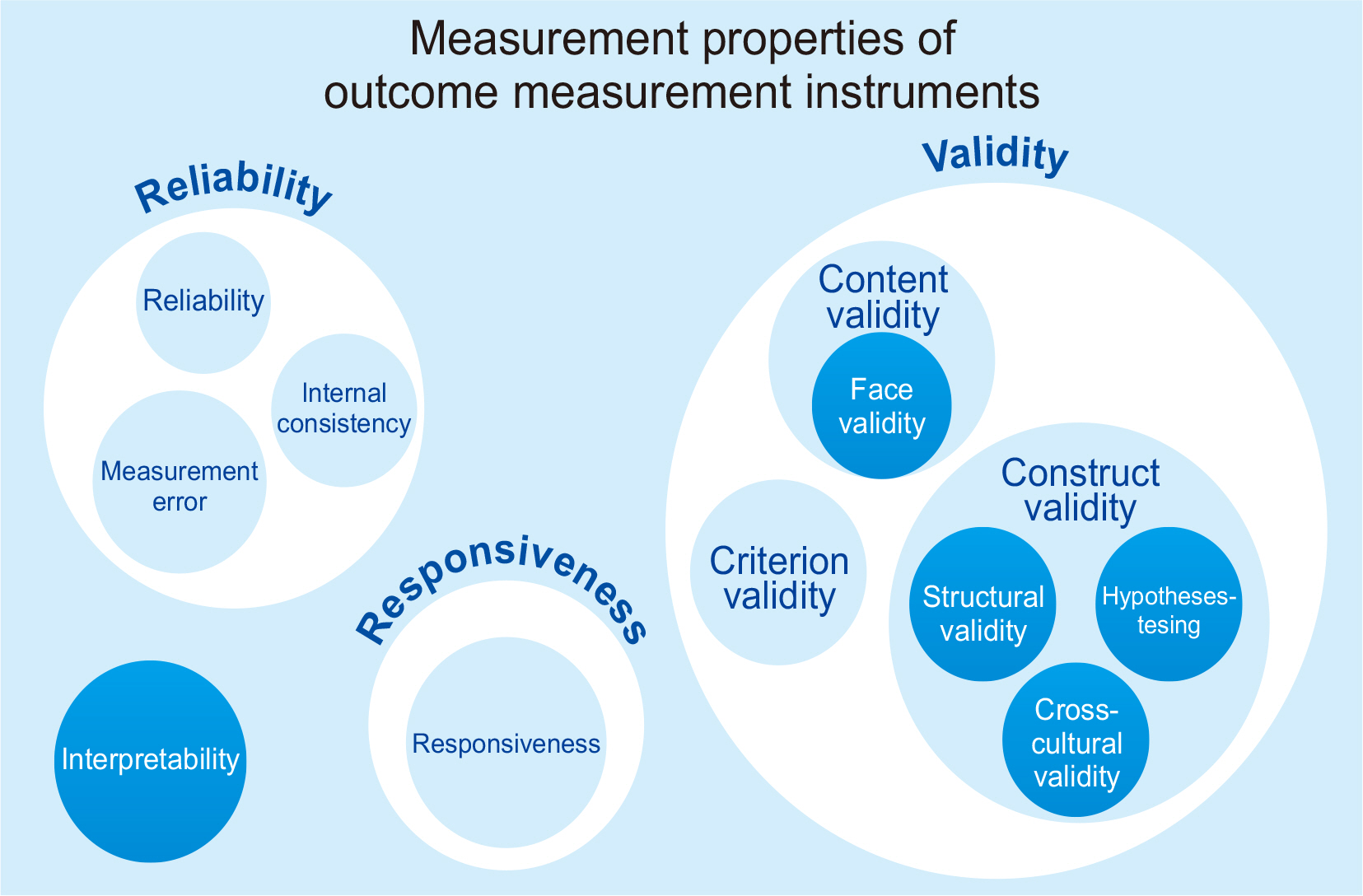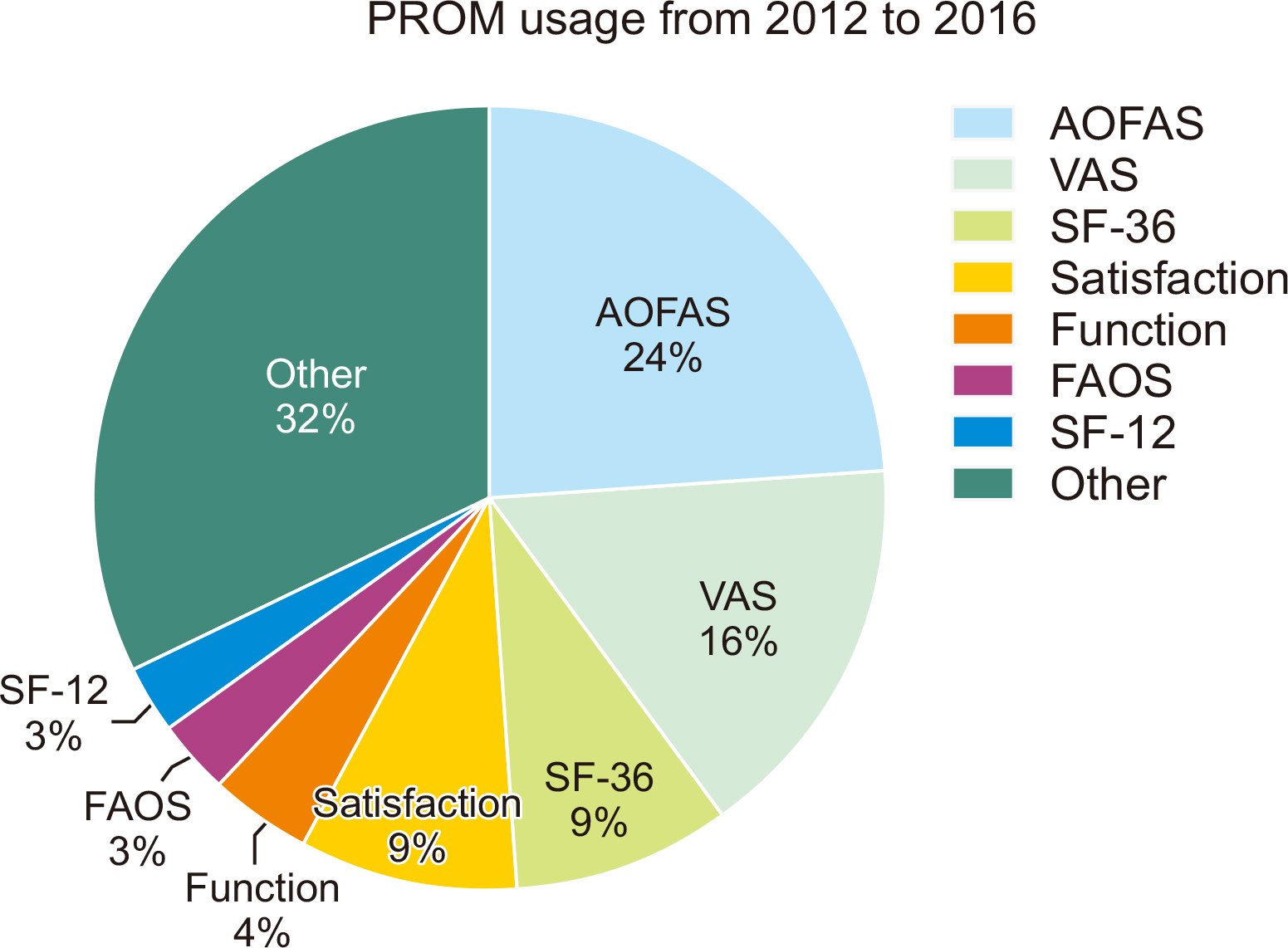J Korean Foot Ankle Soc.
2022 Mar;26(1):1-8. 10.14193/jkfas.2022.26.1.1.
Patient-Reported Outcome Measures of the Foot and Ankle
- Affiliations
-
- 1Department of Orthopaedic Surgery, Kosin University College of Medicine, Busan, Korea
- 2Department of Orthopaedic Surgery, Inha University College of Medicine, Incheon, Korea
- KMID: 2527005
- DOI: http://doi.org/10.14193/jkfas.2022.26.1.1
Abstract
- The patient-reported outcome measures (PROMs) are important in assessing the patient’s overall health, lesion-specific outcomes, and condition-specific outcomes. PROMs are also known as “scoring systems” and are usually in questionnaires. There are almost a hundred different PROMs available in foot and ankle surgery. Each PROM has its merits, demerits, and validity. Selecting an appropriate PROM is important for adequately evaluating a patient’s health status. This article summarizes the most frequently used PROMs in the literature on foot and ankle surgery and presents the authors'recommendations.
Figure
Cited by 1 articles
-
Chronic Longitudinal Rupture of the Tibialis Anterior Tendon: A Case Report
Jiyoun Kim
J Korean Foot Ankle Soc. 2023;27(3):99-102. doi: 10.14193/jkfas.2023.27.3.99.
Reference
-
1. Naal FD, Impellizzeri FM, Rippstein PF. 2010; Which are the most frequently used outcome instruments in studies on total ankle arthroplasty? Clin Orthop Relat Res. 468:815–26. doi: 10.1007/s11999-009-1036-y. DOI: 10.1007/s11999-009-1036-y. PMID: 19672670. PMCID: PMC2816756.
Article2. Hunt KJ, Lakey E. 2018; Patient-reported outcomes in foot and ankle surgery. Orthop Clin North Am. 49:277–89. doi: 10.1016/j.ocl.2017.11.014. DOI: 10.1016/j.ocl.2017.11.014. PMID: 29499828.
Article3. American Academy of Orthopaedic Surgeons. 2016. Instruments for collection of orthopaedic quality data. American Academy of Orthopaedic Surgeons;Rosemont:4. Scott J, Huskisson EC. 1976; Graphic representation of pain. Pain. 2:175–84. doi: 10.1016/0304-3959(76)90113-5. DOI: 10.1016/0304-3959(76)90113-5. PMID: 1026900.
Article5. Ware JE Jr, Sherbourne CD. 1992; The MOS 36-item short-form health survey (SF-36). I. Conceptual framework and item selection. Med Care. 30:473–83. doi: 10.1097/00005650-199206000-00002. DOI: 10.1097/00005650-199206000-00002. PMID: 1593914.6. Kitaoka HB, Alexander IJ, Adelaar RS, Nunley JA, Myerson MS, Sanders M. 1994; Clinical rating systems for the ankle-hindfoot, midfoot, hallux, and lesser toes. Foot Ankle Int. 15:349–53. doi: 10.1177/107110079401500701. DOI: 10.1177/107110079401500701. PMID: 7951968.
Article7. Budiman-Mak E, Conrad KJ, Roach KE. 1991; The Foot Function Index: a measure of foot pain and disability. J Clin Epidemiol. 44:561–70. doi: 10.1016/0895-4356(91)90220-4. DOI: 10.1016/0895-4356(91)90220-4. PMID: 2037861.
Article8. EuroQol Group. 1990; EuroQol--a new facility for the measurement of health-related quality of life. Health Policy. 16:199–208. doi: 10.1016/0168-8510(90)90421-9. DOI: 10.1016/0168-8510(90)90421-9. PMID: 10109801.9. Lakey E, Hunt KJ. 2019; Patient-reported outcomes in foot and ankle orthopedics. Foot Ankle Orthop. 4:2473011419852930. doi: 10.1177/2473011419852930. DOI: 10.1177/2473011419852930. PMID: 35097329. PMCID: PMC8500394.
Article10. Nilsson-Helander K, Thomeé R, Silbernagel KG, Thomeé P, Faxén E, Eriksson BI, et al. 2007; The Achilles tendon Total Rupture Score (ATRS): development and validation. Am J Sports Med. 35:421–6. doi: 10.1177/0363546506294856. Erratum in: Am J Sports Med. 2011;39:NP8.DOI: 10.1177/0363546506294856. PMID: 17158277.11. Domsic RT, Saltzman CL. 1998; Ankle osteoarthritis scale. Foot Ankle Int. 19:466–71. doi: 10.1177/107110079801900708. DOI: 10.1177/107110079801900708. PMID: 9694125. PMCID: PMC8127667.
Article12. Kearney RS, Achten J, Lamb SE, Plant C, Costa ML. 2012; A systematic review of patient-reported outcome measures used to assess Achilles tendon rupture management: what's being used and should we be using it? Br J Sports Med. 46:1102–9. doi: 10.1136/bjsports-2011-090497. DOI: 10.1136/bjsports-2011-090497. PMID: 22089078.
Article13. Jia Y, Huang H, Gagnier JJ. 2017; A systematic review of measurement properties of patient-reported outcome measures for use in patients with foot or ankle diseases. Qual Life Res. 26:1969–2010. doi: 10.1007/s11136-017-1542-4. DOI: 10.1007/s11136-017-1542-4. PMID: 28315178.
Article14. Mokkink LB, Terwee CB, Patrick DL, Alonso J, Stratford PW, Knol DL, et al. 2010; The COSMIN study reached international consensus on taxonomy, terminology, and definitions of measurement properties for health-related patient-reported outcomes. J Clin Epidemiol. 63:737–45. doi: 10.1016/j.jclinepi.2010.02.006. DOI: 10.1016/j.jclinepi.2010.02.006. PMID: 20494804.
Article15. Terwee CB, Bot SD, de Boer MR, van der Windt DA, Knol DL, Dekker J, et al. 2007; Quality criteria were proposed for measurement properties of health status questionnaires. J Clin Epidemiol. 60:34–42. doi: 10.1016/j.jclinepi.2006.03.012. DOI: 10.1016/j.jclinepi.2006.03.012. PMID: 17161752.
Article16. van Tulder M, Furlan A, Bombardier C, Bouter L. 2003; Updated method guidelines for systematic reviews in the cochrane collaboration back review group. Spine (Phila Pa 1976). 28:1290–9. doi: 10.1097/01.BRS.0000065484.95996.AF. DOI: 10.1097/01.BRS.0000065484.95996.AF. PMID: 12811274.
Article17. Prinsen CAC, Mokkink LB, Bouter LM, Alonso J, Patrick DL, de Vet HCW, et al. 2018; COSMIN guideline for systematic reviews of patient-reported outcome measures. Qual Life Res. 27:1147–57. doi: 10.1007/s11136-018-1798-3. DOI: 10.1007/s11136-018-1798-3. PMID: 29435801. PMCID: PMC5891568.
Article18. Hunt KJ, Hurwit D. 2013; Use of patient-reported outcome measures in foot and ankle research. J Bone Joint Surg Am. 95:e118(1-9). DOI: 10.2106/JBJS.L.01476. PMID: 23965711.
Article19. Pinsker E, Daniels TR. 2011; AOFAS position statement regarding the future of the AOFAS Clinical Rating Systems. Foot Ankle Int. 32:841–2. doi: 10.3113/FAI.2011.0841. DOI: 10.3113/FAI.2011.0841. PMID: 22097157.
Article20. Malviya A, Makwana N, Laing P. 2007; Correlation of the AOFAS scores with a generic health QUALY score in foot and ankle surgery. Foot Ankle Int. 28:494–8. doi: 10.3113/FAI.2007.0494. DOI: 10.3113/FAI.2007.0494. PMID: 17475146.
Article21. Ferreira-Valente MA, Pais-Ribeiro JL, Jensen MP. 2011; Validity of four pain intensity rating scales. Pain. 152:2399–404. doi: 10.1016/j.pain.2011.07.005. DOI: 10.1016/j.pain.2011.07.005. PMID: 21856077.
Article22. Kersten P, White PJ, Tennant A. 2014; Is the pain visual analogue scale linear and responsive to change? An exploration using Rasch analysis. PLoS One. 9:e99485. doi: 10.1371/journal.pone.0099485. DOI: 10.1371/journal.pone.0099485. PMID: 24921952. PMCID: PMC4055724.
Article23. Busija L, Osborne RH, Nilsdotter A, Buchbinder R, Roos EM. 2008; Magnitude and meaningfulness of change in SF-36 scores in four types of orthopedic surgery. Health Qual Life Outcomes. 6:55. doi: 10.1186/1477-7525-6-55. DOI: 10.1186/1477-7525-6-55. PMID: 18667085. PMCID: PMC2527304.
Article24. Laucis NC, Hays RD, Bhattacharyya T. 2015; Scoring the SF-36 in orthopaedics: a brief guide. J Bone Joint Surg Am. 97:1628–34. doi: 10.2106/JBJS.O.00030. DOI: 10.2106/JBJS.O.00030. PMID: 26446970. PMCID: PMC5029523.
Article25. Jenkinson C, Layte R, Jenkinson D, Lawrence K, Petersen S, Paice C, et al. 1997; A shorter form health survey: can the SF-12 replicate results from the SF-36 in longitudinal studies? J Public Health Med. 19:179–86. doi: 10.1093/oxfordjournals.pubmed.a024606. DOI: 10.1093/oxfordjournals.pubmed.a024606. PMID: 9243433.
Article26. Gosling CM, Gabbe BJ, Williamson OD, Sutherland AM, Cameron PA. 2011; Validity of outcome measures used to assess one and six month outcomes in orthopaedic trauma patients. Injury. 42:1443–8. doi: 10.1016/j.injury.2011.05.022. DOI: 10.1016/j.injury.2011.05.022. PMID: 21684543.
Article27. Hijji FY, Schneider AD, Pyper M, Laughlin RT. 2020; The popularity of outcome measures used in the foot and ankle literature. Foot Ankle Spec. 13:58–68. doi: 10.1177/1938640019826680. DOI: 10.1177/1938640019826680. PMID: 30773056.
Article28. Brooks R. 1996; EuroQol: the current state of play. Health Policy. 37:53–72. doi: 10.1016/0168-8510(96)00822-6. DOI: 10.1016/0168-8510(96)00822-6. PMID: 10158943.
Article29. Mani SB, Brown HC, Nair P, Chen L, Do HT, Lyman S, et al. 2013; Validation of the Foot and Ankle Outcome Score in adult acquired flatfoot deformity. Foot Ankle Int. 34:1140–6. doi: 10.1177/1071100713483117. DOI: 10.1177/1071100713483117. PMID: 23513031.
Article30. Golightly YM, Devellis RF, Nelson AE, Hannan MT, Lohmander LS, Renner JB, et al. 2014; Psychometric properties of the foot and ankle outcome score in a community-based study of adults with and without osteoarthritis. Arthritis Care Res (Hoboken). 66:395–403. doi: 10.1002/acr.22162. DOI: 10.1002/acr.22162. PMID: 24023029. PMCID: PMC4211630.
Article31. Lee KM, Chung CY, Kwon SS, Sung KH, Lee SY, Won SH, et al. 2013; Transcultural adaptation and testing psychometric properties of the Korean version of the Foot and Ankle Outcome Score (FAOS). Clin Rheumatol. 32:1443–50. doi: 10.1007/s10067-013-2288-1. DOI: 10.1007/s10067-013-2288-1. PMID: 23703359.
Article32. Shazadeh Safavi P, Janney C, Jupiter D, Kunzler D, Bui R, Panchbhavi VK. 2019; A systematic review of the outcome evaluation tools for the foot and ankle. Foot Ankle Spec. 12:461–70. doi: 10.1177/1938640018803747. DOI: 10.1177/1938640018803747. PMID: 30338697.
Article33. In TS, Jung JH, Kim K, Jung KS, Cho HY. 2017; The reliability and validity of the Korean version of the foot function index for patients with foot complaints. J Phys Ther Sci. 29:53–56. doi: 10.1589/jpts.29.53. DOI: 10.1589/jpts.29.53. PMID: 28210038. PMCID: PMC5300804.
Article34. Huh JW, Eun IS, Ko YC, Park MJ, Hwang KM, Park SH, et al. 2016; Reliability and validity of the Korean version of the Foot Function Index. J Foot Ankle Surg. 55:759–61. doi: 10.1053/j.jfas.2016.03.011. DOI: 10.1053/j.jfas.2016.03.011. PMID: 27067199.
Article35. Budiman-Mak E, Conrad K, Stuck R, Matters M. 2006; Theoretical model and Rasch analysis to develop a revised Foot Function Index. Foot Ankle Int. 27:519–27. doi: 10.1177/107110070602700707. DOI: 10.1177/107110070602700707. PMID: 16842719.
Article36. Budiman-Mak E, Conrad KJ, Mazza J, Stuck RM. 2013; A review of the foot function index and the foot function index - revised. J Foot Ankle Res. 6:5. doi: 10.1186/1757-1146-6-5. DOI: 10.1186/1757-1146-6-5. PMID: 23369667. PMCID: PMC3579714.
Article37. Hale SA, Hertel J. 2005; Reliability and sensitivity of the Foot and Ankle Disability Index in subjects with chronic ankle instability. J Athl Train. 40:35–40. PMID: 15902322. PMCID: PMC1088343.38. Martin RL, Irrgang JJ, Burdett RG, Conti SF, Van Swearingen JM. 2005; Evidence of validity for the Foot and Ankle Ability Measure (FAAM). Foot Ankle Int. 26:968–83. doi: 10.1177/107110070502601113. DOI: 10.1177/107110070502601113. PMID: 16309613.
Article39. Dawson J, Coffey J, Doll H, Lavis G, Cooke P, Herron M, et al. 2006; A patient-based questionnaire to assess outcomes of foot surgery: validation in the context of surgery for hallux valgus. Qual Life Res. 15:1211–22. doi: 10.1007/s11136-006-0061-5. DOI: 10.1007/s11136-006-0061-5. PMID: 17001437.
Article40. Dawson J, Doll H, Coffey J, Jenkinson C. 2007; Responsiveness and minimally important change for the Manchester-Oxford foot questionnaire (MOXFQ) compared with AOFAS and SF-36 assessments following surgery for hallux valgus. Osteoarthritis Cartilage. 15:918–31. doi: 10.1016/j.joca.2007.02.003. Erratum in: Osteoarthritis Cartilage. 2011;19:920.DOI: 10.1016/j.joca.2007.02.003. PMID: 17383907.
Article41. Venkatesan M, Aziz S, Mahadevan D, Korim T, Dias J, Bhatia M. 2020; Evaluation of validity, reliability, and feasibility of 3 patient-reported foot and ankle outcome measures. J Foot Ankle Surg. 59:507–12. doi: 10.1053/j.jfas.2019.09.033. DOI: 10.1053/j.jfas.2019.09.033. PMID: 32354509.
Article42. Pinsker E, Inrig T, Daniels TR, Warmington K, Beaton DE. 2015; Reliability and validity of 6 measures of pain, function, and disability for ankle arthroplasty and arthrodesis. Foot Ankle Int. 36:617–25. doi: 10.1177/1071100714566624. DOI: 10.1177/1071100714566624. PMID: 25652665.
Article43. Madeley NJ, Wing KJ, Topliss C, Penner MJ, Glazebrook MA, Younger AS. 2012; Responsiveness and validity of the SF-36, Ankle Osteoarthritis Scale, AOFAS Ankle Hindfoot Score, and Foot Function Index in end stage ankle arthritis. Foot Ankle Int. 33:57–63. doi: 10.3113/FAI.2012.0057. DOI: 10.3113/FAI.2012.0057. PMID: 22381237.
Article44. Wing KJ, Chapinal N, Coe MP, Daniels TR, Glazebrook M, Dryden P, et al. 2017; Measuring the operative treatment effect in end-stage ankle arthritis: are we asking the right questions? A COFAS multicenter study. Foot Ankle Int. 38:1064–9. doi: 10.1177/1071100717714953. DOI: 10.1177/1071100717714953. PMID: 28671032.
Article45. Croft S, Wing KJ, Daniels TR, Glazebrook M, Dryden P, Younger A, et al. 2017; Association of Ankle Arthritis Score with need for revision surgery. Foot Ankle Int. 38:939–43. doi: 10.1177/1071100717712891. DOI: 10.1177/1071100717712891. PMID: 28617095.
Article46. Park YH, Cho HW, Choi JW, Kim HJ. 2021; Validation and cross-cultural adaptation of the Korean translation of the Achilles tendon Total Rupture Score. BMC Musculoskelet Disord. 22:876. doi: 10.1186/s12891-021-04765-w. DOI: 10.1186/s12891-021-04765-w. PMID: 34649549. PMCID: PMC8518316.
Article47. McKeown R, Rabiu AR, Ellard DR, Kearney RS. 2019; Primary outcome measures used in interventional trials for ankle fractures: a systematic review. BMC Musculoskelet Disord. 20:388. doi: 10.1186/s12891-019-2770-2. DOI: 10.1186/s12891-019-2770-2. PMID: 31455297. PMCID: PMC6712770.
Article48. American Academy of Orthopaedic Surgeons (AAOS). Patient reported outcome measures. Quality Measures [Internet]. AAOS;Rosemont (IL): Available from: https://www.aaos.org/quality/research-resources/patient-reported-outcomemeasures. cited 2021 Dec 30.49. Lee DY, Kim YM, Lee JH, Kim J, Kim JB, Kim BS, et al. 2019; Validation of electronic foot function index in patients with foot and ankle disease: a randomized, prospective multicenter study. J Korean Foot Ankle Soc. 23:24–30. doi: 10.14193/jkfas.2019.23.1.24. DOI: 10.14193/jkfas.2019.23.1.24.
Article50. Park JY, Kim BS, Lee HJ, Kim YM, Kim HN, Kang HJ, et al. 2019; Comparison between an electronic version of the foot and ankle outcome score and the standard paper version: a randomized multicenter study. Medicine (Baltimore). 98:e17440. doi: 10.1097/MD.0000000000017440. DOI: 10.1097/MD.0000000000017440. PMID: 31577765. PMCID: PMC6783211.
- Full Text Links
- Actions
-
Cited
- CITED
-
- Close
- Share
- Similar articles
-
- How Effective Is the Injection Therapy in Foot and Ankle Disorder?
- The Methods for Foot Function Index and Foot and Ankle Outcome Score Measurement: A Comparison between Paper-and-Pencil Method and Electronic Method
- Tibial Axis-Talar Ratio Measured on Standing Ankle Lateral Radiographs
- Ankle Arthrodesis
- Rehabilitation of Common Ankle and Foot Sports Injuries



